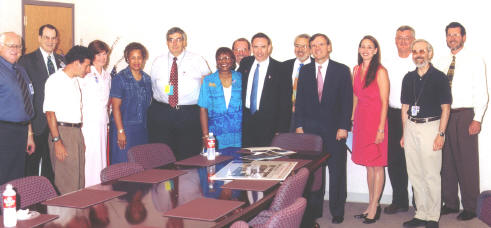October 2002, Volume 1, Issue
1
NCTR Welcomed Tommy Thompson, Secretary of Department of Health and Human
Services
On Friday, July 19, 2002, Tommy Thompson, Secretary
of Health and Human Services, visited the Jefferson Laboratories of the Food and
Drug Administration (FDA) for an overview of the programs and a tour of the
facilities. This was the first visit of a Secretary to the campus. Accompanying
the Secretary was U.S. Senator Tim Hutchison. The Secretary and Senator were
given a tour of the Phototoxicology Laboratory (one of only two in the country)
where Dr. Paul Howard explained the ongoing research with cosmetics and dietary
supplements and demonstrated the experimental setup, which emulates varying
degrees of sunlight exposure to a test animal. Dr. Carl Cerniglia
explained the Microbiology Division’s research on food safety and
antimicrobial resistance. Dr. Bill Slikker described NCTR’s neurobehavioral
studies using a cross-species operant test battery developed by Center
scientists. The tour ended with Dr. Jim Fuscoe, Center of Functional Genomics,
demonstrating the new robotic equipment used to produce microarrays
to study gene changes due to adverse health events.

SAB Met August 8-9
The Science Advisory Board (SAB) to the NCTR
advises NCTR’s Director in establishing, implementing and evaluating the NCTR’s
research programs and provides an extra-agency review to ensure that the
research programs at NCTR are scientifically sound and pertinent to FDA
regulatory needs.
The presentations centered around NCTR’s newly developed Centers for
Excellence — Structural Genomics, Functional Genomics, Toxicoinformatics, and
Phototoxicology. These centers will use data derived from new technologies
(genomics, proteomics, and metabonomics) to develop new regulatory standards.

Center for Structural Genomics
Did you know that black women under 50 are twice as
likely to develop breast cancer as white women and that black men have the
highest incidence and mortality rates of prostate cancer in the world? NCTR has
created a new Center for Excellence to study these issues.

The Center for Structural Genomics will conduct studies to identify genes
that predispose people to cancer, identify genes that reduce the effectiveness
of cancer treatment, and define markers to detect moderate elevations of risk
resulting from exposures to cancer-causing agents (including dietary
supplements, over-the-counter medications, foods, drugs, and pesticides) among
susceptible individuals.
“I think this was probably some of the most exciting research I’ve heard
since I’ve been coming.” Nancy Gillett D.V.M., Ph.D., SAB member since 2000.
Recent Publications
NCTR conducts research designed to protect the public’s health. Results from
some of these research projects have recently been accepted for publication in
nationally recognized scientific journals.
- Ang, Catharina, “Determination of St. John's Wort Components in Dietary
Supplements and Functional Foods by Liquid Chromatography”, J. AOAC
International
- Chen, Tao, “Mutations induced by alpha-hydroxytamoxifen in the lacI and
cII genes of Big Blue transgenic rats”, Carcinogenesis
- Dobrovolsky, Vasily, “Analysis of in vivo mutation in the Hprt and Tk
genes of mouse lymphocytes”, Methods in Molecular Biology, Vol. "Molecular
Toxicology Protocols", Humana Press
- Fuscoe, James, “Simultaneous Quantification of t(14;18) and Hprt Exon 2/3
Deletions In Human Lymphocytes”, Methods in Molecular Biology
- Gough, Bobby, “Comparative effects of substituted amphetamines (PMA, MDMA,
and METH) on monoamines in rat caudate. A microdialysis study”, Annals of the
New York Academy of Sciences
- Heflich, Robert, Editorial, Environmental & Molecular Mutagenesis
- Imam, Syed, “Methamphetamine-induced dopaminergic neurotoxicity and
production of peroxynitrite are potentiated in nerve growth factor
differentiated pheochromocytoma 12 cells”, Annals of the New York Academy of
Sciences
- Jakab, Robert, “Parvalbumin neuron circuits and microglia in three
dopamine-poor cortical regions remain sensitive to amphetamine exposure in the
absence of hyperthermia, seizure and stroke”, Brain Research
- Moody, Joanna, “Biotransformation of mirtazapine by Cunninghamella elegans”,
Drug Metabolism and Disposition
- Parsons, Barbara, “ACB-PCR Detection of rare base substitution”, Methods
in Molecular Biology, Molecular Toxicology Protocols
- Poirier, Lionel, “The Effects of Diet, Genetics and Chemicals on Toxicity
and Aberrant DNA Methylation: an Introduction”, Journal of Nutrition
- Poirier, Lionel, “Trans-HHS Workshop: Diet, DNA Methylation Processes and
Health”, The Journal of Nutrition
- Shvartsburg, Alexandre, “Isomer-Resolved Ion Spectroscopy”, Physical
Review Letters
- Virmani, Ashraf, “The protective role of L-carnitine against neurotoxicity
evoked by drug of abuse, methamphetamine, could be related to mitochondrial
dysfunction”, Annals of the New York Academy of Sciences
- Wang, Rong Fu, “Development of a membrane-array method for the detection
of human intestinal bacteria in fecal samples”, Molecular and Cellular Probes
Contact Information:
The NCTR Quarter Page is published four times a year by the Division of
Planning at the National Center for Toxicological Research.
For more information about NCTR, contact Dr. Dan Casciano,
NCTR Director at dcasciano@nctr.fda.gov
or (870)543-7517.
|